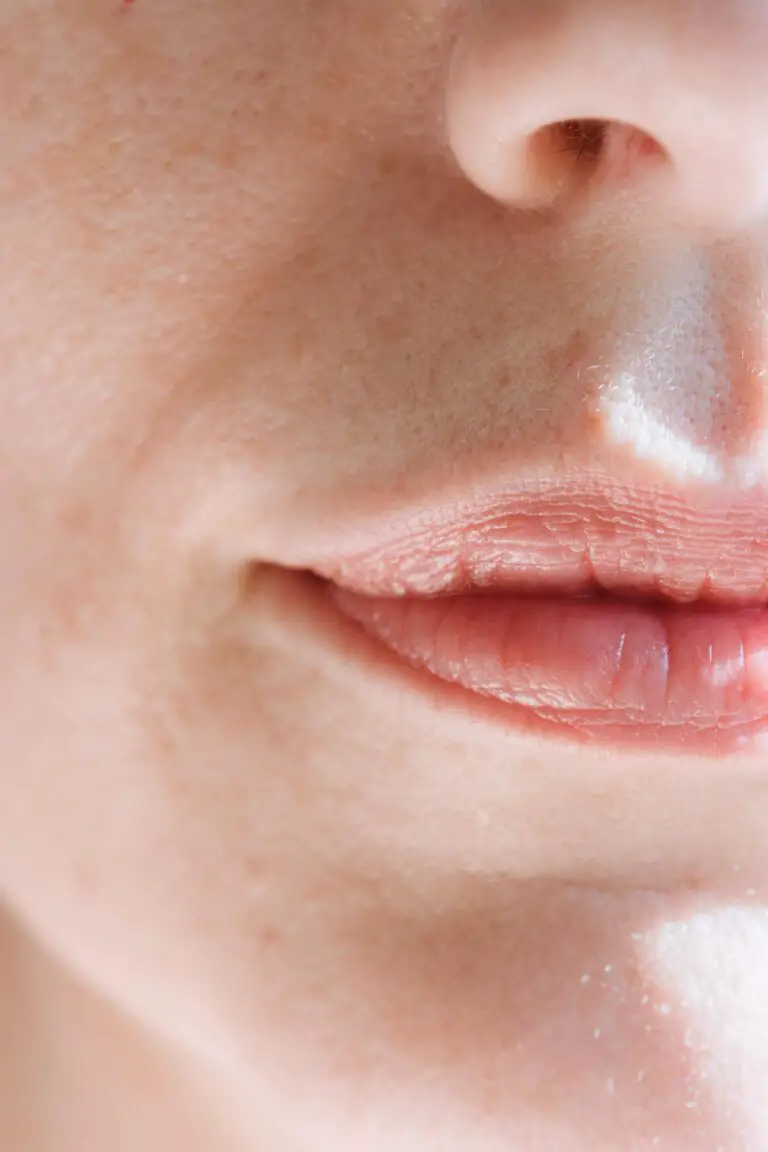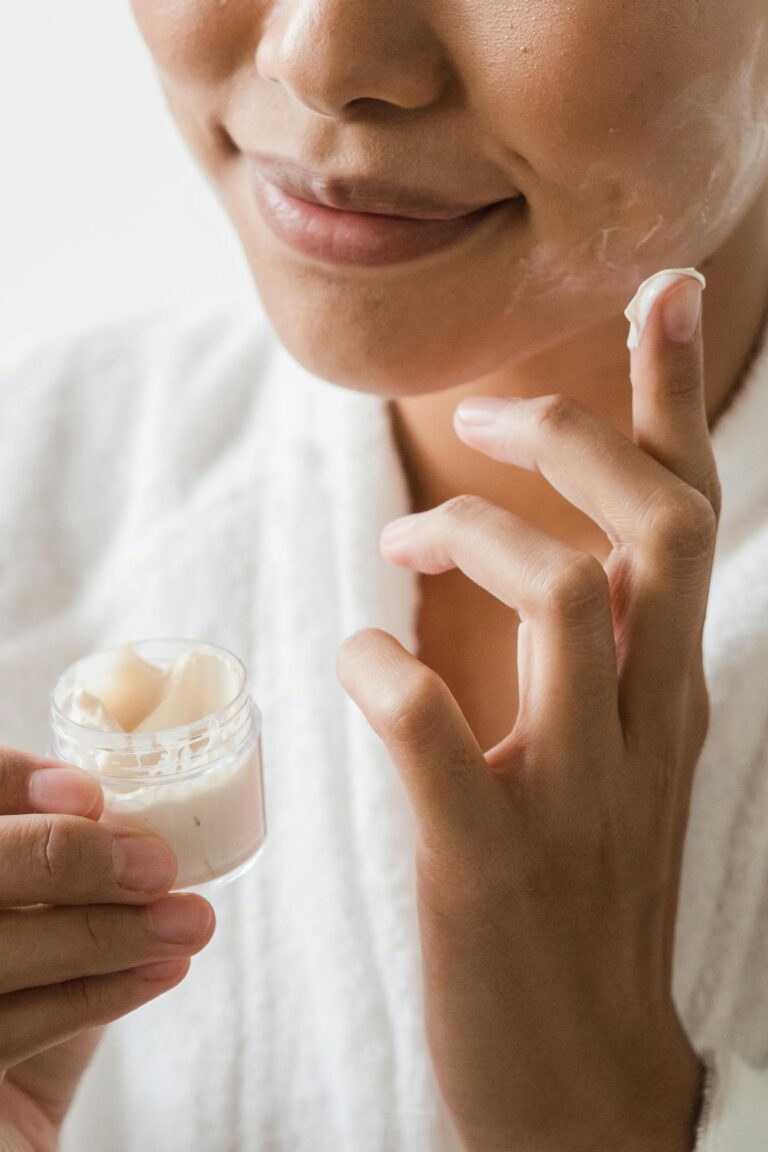The microbiome is that colony of microorganisms that lives on your skin that provides protection against pathogens (the ‘bad’ microorganisms). It helps regulate the immune responses and it strengthens the skin.
When your microbiome is off you’ll notice the signs of skin barrier damage, which can be mild (like slight redness) or severe (like major breakouts).
It very easily happens when you’re using too many products, or when those products are either too harsh or just full of crap (let’s face it – probably the majority!).
I wrote a previous post about the skin’s natural barrier (how to maintain it and repair damage), but there’s been a huge surge in ‘probiotic skincare’ in the past few years, so I thought the microbiome deserved it’s own dedicated post. It’s probably the future of ‘personalized’ skincare and it is quite fascinating.
Here I’ll explain the difference between skin barrier and skin microbiome, as well as the powerful link between the gut and the skin.
I’ll go over the claims and facts of ‘probiotic skincare’, which can be very confusing and misleading – since it’s also pricier, you should definitely know what you’re paying for.
And I’ll finish by laying out how to restore your skin microbiome naturally in the most effective steps, with a simple DIY microbiome-friendly skincare routine.
Is the skin microbiome the same as the skin barrier?
Basically, the skin’s microbiome is an integral part of the skin’s barrier function. In fact, it’s one pillar of four. We have the:
Microbial barrier (microbiome): the community of microbes (bacteria, fungi, viruses) that lives on the surface of the skin – i.e., the microbiome.
Physical barrier: the actual “bricks and mortar” construction that’s known as the stratum corneum (the outermost layer of the skin).
Chemical barrier (acid mantle): the chemical environment (pH) that regulates and controls the bacteria that’s “allowed” to proliferate – by nature it’s slightly acidic.
(Innate and adaptive) immune barrier: the microbes on the skin stimulate immune responses from the body, which will trigger the release of natural antimicrobial and antibiotic peptides and proteins.
All these “layers” are essential – they interact with each other and affect one another to create healthy skin. They’re all influenced by environmental factors, diet and age related internal changes.
The microbiome is thought to start forming already in the fetus stage and it’s added to at the time of birth, when the baby passes through the mother’s birth canal. The drastic changes in hormones that happen at puberty and menopause also cause major shifts in the microbiome of the skin.
The composition is also distinctive to each individual person and body part, with clear differences between dry and humid parts of the body, as well as according to the thickness of the hair follicles.
Related post: Your Holistic Guide To Repair a Damaged Skin Barrier Naturally
How the gut microbiome affects the skin microbiome
There is a bidirectional (in both directions) connection between the skin and other so-called “barrier sites”, like the intestines and the lungs. That means that the microbiome composition of one affects and interplays with the microbiome of the other – there’s a symbiotic relationship – it’s known as the gut-skin axis.
The specific gut microbiome has a significant impact on the general balance of the skin’s health and microbiome composition. And when the integrity of the intestinal barrier is damaged, it’s also unable to prevent bacteria from entering the bloodstream, affecting the health of the skin.
An unbalanced gut microbiome actively damages the skin barrier function, causing inflammatory skin diseases like acne, psoriasis, rosacea, etc.
How aging affects the skin microbiome
Several things affect the skin quality and barrier function as we age, both internally and externally:
Internally
- (Epi)Genetics
- Changes in hormones
- Cellular metabolism and accumulation of senescent cells (cells that have finally stopped dividing and can compromise tissue regeneration)
- Metabolic processes
Externally
- UV damage from the sun
- Pollution
- Chemicals and toxins
All of the above leads to less water retention (less moisture and plumpness), more vulnerability to infection and inflammation.
The benefits of using probiotics on the skin
What’s the deal with ‘probiotic skincare’?
There’s a lot of confusion and mishandling of the term “probiotic skincare”. When most people hear the term probiotic, they immediately assume that it will contain “live cultures” and that just isn’t the case for most probiotic skincare formulas.
For one thing, it’s very difficult to preserve a product that contains live cultures with the typical preservation system (preservatives) that are designed to effectively kill bacteria – they can’t tell good bacteria from bad, obviously.
But even when more sophisticated methods are used, they still require fidgety handling and storage, since they’re very sensitive to temperature, humidity and general conditions. Cue those silly skincare fridges.
On top of that, there’s also the problem of dosage and type of bacteria to use. There’s been a lot of research on skin microbiota, but we’re still very much just scratching the surface with this stuff – there’s a lot we don’t know.
Sometimes the choice of one company to use one strain or bacteria over another is simply because they’re less fussy to preserve in the product and not necessarily because they’ve been proven to be “better”. Also, each person will have different needs – remember everyone’s microbiome is different.
So, the term “probiotic skincare” can actually be used to mean everything from prebiotic (promotes the growth of live microorganisms – i.e. food), to postbiotic (the metabolic products or byproducts of live microorganisms), synbiotic (a mixture of probiotics and prebiotics) and even paraprobiotic (the inactivated cells of live microorganisms).
Most probiotic skincare out there is actually made with lysates and fermented extracts, which are basically postbiotics but very nutrient-rich. They’re wonderful for the skin, but not strictly speaking “probiotic”. Although, postbiotics have been shown to produce a biological response similar to their live culture equivalents.
Nevertheless, all have been shown to benefit and promote a healthy microbiome in different ways.
How to restore your skin microbiome & increase good bacteria naturally
You can do this basically two ways – by putting probiotics directly on the skin or by promoting conditions for a healthy microbiome to develop (by using the other ‘biotics’ mentioned, externally as skincare and internally through diet).
As mentioned earlier, diet is very important for maintaining a good skin microbiome, because the skin and the gut are intimately connected.
The nutrients you consume will also allow the skin to perform the necessary functions to keep itself healthy. It will itself then create the essential nutrients for the microbiota to thrive, like amino acids, fatty acids, sebum and lactic acids.
So, in order to properly restore your skin microbiome make sure your approach is holistic – internal and external.
Internally
Diet
Make sure you consume natural probiotics regularly, like yogurt, kefir, sauerkraut, kimchi, miso, natto, kombucha, etc.
Include a variety of prebiotic foods to make sure the probiotics have plenty of “food” to thrive on.
These are typically fruits and veggies high in indigestible fiber, which the microbiota of the gut loves. Things like mushrooms, onions and garlic, cabbage, asparagus, leeks, oats, barley, flaxseeds, vinegars, cocoa powder, almonds, cashews, apples, bananas, avocados, kiwifruit, dandelion greens, chicory root, Jerusalem artichoke, and legumes in general.
Probiotic supplements
If you’re consuming fermented foods regularly, there’s probably no need to take supplemental probiotics. However, if you’re suffering from skin issues, it might speed up your results to take supplements for a few months.
Even in normal situations, certain supplements (Lactobacillus) have been shown to increase skin thickness, sebum production and to significantly reduce transepidermal water loss, which is a positive indicator of skin barrier function. It’s also been shown to speed up skin healing.
Other supplements (Bifidobacterium) have also been proven to reduce the oxidative stress induced by UV exposure.
Externally
The actual fun part – skincare!
You want to create an optimal environment to nourish the growth of beneficial bacteria and support the skin’s natural barrier function. This is a reciprocal and dynamic relationship – the microbiome is part of the barrier function of the skin and it needs the other parts (physical, chemical and immune) to function correctly. And they need it to help maintain the integrity of the structure.
A microbiome-friendly skincare routine
Gentle cleansers
Go for something that is less likely to disturb the skin barrier, so avoid foam and surfactant-based cleansers, because they disrupt and degrade the barrier function. They can also penetrate the skin and damage the living cells deeper in the skin, causing changes in structure and inflammation.
Surfactant-based cleansers are soaps and anything that contains sodium lauryl sulfate, ammonium laureth sulfate, or disodium lauryl sulfosuccinate (among others) and items like micellar water.
Instead choose cream or oil based cleansers. The classic cold cream is an excellent choice here, as well as the DIY oil cleansing method. Also, water only face washing.
Related post: The Most Effective Homemade Face Cleansers (the simplest methods)
Microbiome boosting face masks
Once or twice a week you can do a microbiome boosting face mask, to help support and nourish the good microbiota of the skin.
You can do this by adding live cultures (supplements) directly to whatever DIY mask you’re doing, if you want, but it’s not really necessary and it might just be more beneficial for your skin if you were to consume the supplements directly.
Again, we don’t really know just how much bacteria you’d need to add to actually “fix” issues or balance the skin microbiome. There’s also no telling how those microorganisms might interact with the other ingredients in the face mask. When you’re working with naturally sourced ingredients, at least you know that their unique composition is naturally balanced and optimized by evolution.
So the simplest way is to apply naturally pre-, pro- and postbiotic ingredients to your face as a mask. You can get very creative with your combinations, or just keep it simple and hassle-free (my personal favorite). Below are some very basic recipes, with easy to source and “biotic” rich ingredients that are great for skin.
Honey mask
Contains prebiotic sugar compounds, like oligosaccharides and polysaccharides.
- 1 tsp pure raw honey
Wet your hands and rub the honey on the palm of your hand until you see that the texture feels less viscous. Apply to the face and leave on for about 20 minutes. Wash off with water.
Probiotic Yogurt mask
The yogurt contains prebiotic sugars like lactose, postbiotic acids like lactic acid and citric acid, and actual probiotic bacteria like Streptococcus thermophiles, Lactobacillus and Bifidobacterium. As you can see, yogurt is a pretty complete “biotic” food, but you can boost it by adding ingredients like brewer’s yeast and/or honey.
- 3 tsp yogurt
- 1 tsp raw honey (opt.)
- 1 tsp brewer’s yeast powder (opt.)
Make into a paste and apply to face. Leave on for 20 minutes and wash off with water.
Fruit face mask
Bananas contain prebiotic sugars like oligosaccharides and inulin.
- 1 ripe banana
- 1 or 2 tsp honey (depending on the size of the banana – wink wink)
- ½ tsp brewer’s yeast (opt.)
Smash the banana, add the honey and mix to form a paste. Apply to the face, leave on for 20 minutes and wash off with water.
Slightly acidic toner
The skin needs a slightly acidic environment in order to maintain barrier function and a healthy microbiome.
In cases of skin abnormalities, like dryness, redness, or breakouts, topical acidification of the skin has been shown to help restore its barrier function.
This is very simple to DIY too.
- 1 part vinegar
- 7 parts distilled water
Just mix together in a glass spray bottle and it’s ready to use. This makes a mild toner. If your skin reacts well (doesn’t get red) you can try increasing the vinegar amount, although it’s not necessary.
You can use any kind of food grade vinegar, since all will lower the pH level and contain acetic acid, which is also a postbiotic.
Depending on what the vinegar was made from (wine, rice, fruits, etc.) it will also contain different phenolic compounds and antioxidants that will be beneficial for the skin. Apple cider vinegar, for instance, will also contain malic acid, lactic acid and citric acid – all postbiotics.
Vinegars are also antimicrobial and anti-inflammatory, which will help heal congested skin. By being slightly acidic, it also helps to mildly exfoliate the skin over time, helping to resurface fresher and healthier skin.
Related post: So You Just Want a Simple DIY Face Toner? Here’s 4
Microbiome-friendly moisturizers
Choose a moisturizer with skin barrier loving ingredients that are going to support the right kind of microorganisms.
Jojoba oil, on the other hand, is the closest in composition to the skin’s actual sebum (natural oils).
Shea butter has been proven to enhance tissue repair and it’s also a very microbiome-friendly ingredient. It has antibacterial and antifungal properties against specific microorganisms that are detrimental to the skin, like Pseudomonas aeruginosa, Staphylococcus aureus, Candida albicans, and Aspergillus niger. It’s also very nourishing and moisturizing.
If you want a simple DIY microbiome-friendly cream moisturizer, I have another post that shares a basic barrier repair cream recipe, made with specific microbiome-loving ingredients that help repair and nourish the skin barrier. You might want to give that a go.
If you don’t want to fuss with making creams, you can also just get very basic and use the DIY 2-step moisturizing approach I discussed in a previous post, where you basically apply your choice of oils/fats to the skin with a massage, while the skin is still wet from the toner. For instance:
- First step: Spray your face with the vinegar-water toner
- Second step: Take a dollop of Shea butter, rub it in the palm of your hands until it softens a bit and apply it to your face and neck in upward strokes and circular motions, while the skin is still wet from the toner, and massage that in until everything is absorbed.
- Alternatively: You can also mix a dollop of aloe vera gel with 5 or 6 drops of jojoba oil (or whatever your choice of oils), mix it together and apply that to the skin.
The variations are endless. If you want even more suggestions of possible combinations of water and oil ingredients, go check out that post, where I go into more detail.
This is how to restore your skin microbiome in the simplest steps. Just pair down your skincare routine as much as you can, stop the harsh cleansers (and the double cleansing!) and introduce as many barrier-friendly ingredients as possible.
As always, don’t underestimate the importance of diet – food as an enormous effect on your health and mood. And give it time – if you’re consistent, it will find its natural balance. The body WANTS homeostasis – it’s always striving for it, you just need to give it the resources it needs.








